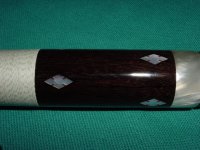Question for you guys. I have an old Meyer cue, looks similar to a palmer. I sent it out to be refinished. When it come back two MOP diamond inlays look discolored on one edge, like a stain or something. However no stain was used.
I was told it could be some dust from stripping or finish got below the cracked inlay. The inlays may need to be replaced but that is unknown at this point until I send the cue back. I didn't think it possible to see anything beneath a MOP inlay since its not clear or opaque to my knowledge.
Have any of you guys ever had similar happen? Just curious and wanted to ask first before I proceed.
Here is a pic of both, although one only has a slight problem. Both are to the left side.
Rod
I was told it could be some dust from stripping or finish got below the cracked inlay. The inlays may need to be replaced but that is unknown at this point until I send the cue back. I didn't think it possible to see anything beneath a MOP inlay since its not clear or opaque to my knowledge.
Have any of you guys ever had similar happen? Just curious and wanted to ask first before I proceed.
Here is a pic of both, although one only has a slight problem. Both are to the left side.
Rod

